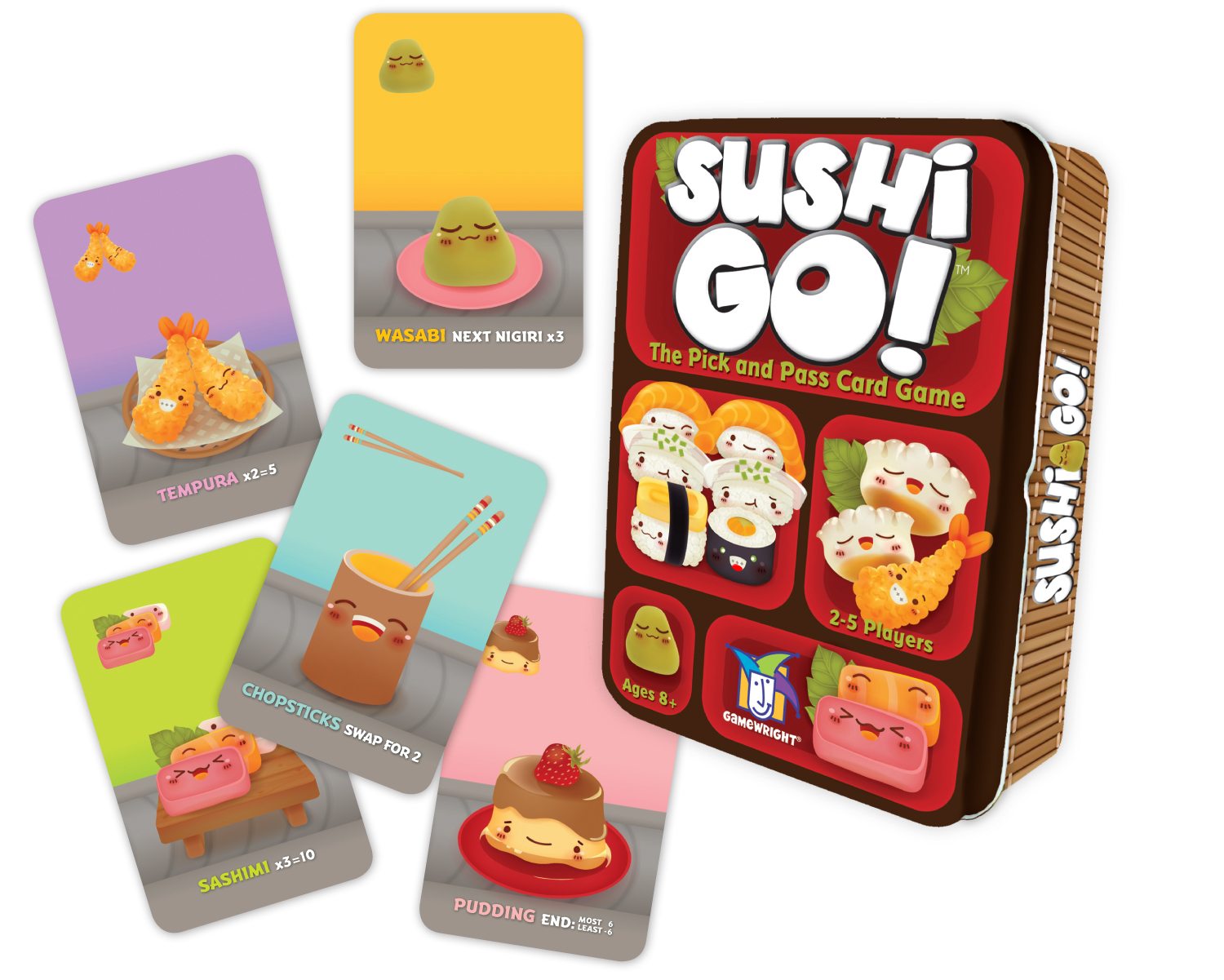
Every Monday night, we have family night. It’s a time that is designated for family interaction that doesn’t include electronics. More often than not, we put in a movie and sit down to play a game. And while Monopoly is fine and Uno is great, playing them every Monday night was getting boring. I decided it was time to dish up something new. It was time for a little sushi.
Sushi Go! by Gamewright was recommended to me by a friend over at The Read Pile. Knowing my 9-year-old son like he does, my friend told me it would be a good intro card game before hitting up harder titles, like Munchkin.
Looking over Gamewright’s website, they say that the game is for ages 8 and up and reinforces the ideas of probability, strategic thinking, and visual discrimination.
As the name implies, each card has a type of sushi drawn in an overly adorable fashion and a designated point value.

In terms of setup, Sushi Go! is as simple as Uno and consists of three rounds.
To start the game, the dealer gives everyone their first set of cards (the number of cards is determined by how many people are playing). Once everyone has their hand, they look it over, take the card they feel is the most valuable, and put it face down in front of them. Next, everyone passes their hand off to the player to their right and you pull another card. This happens only as many times as there are players in the game, so that everyone has a chance at everyone’s first hand.
Once the cards have made a full round, you turn them over, reveal your choices, and the scorekeeper marks down everyone’s points (and in case you’re wondering, yes, there is an app for this).
This is where the strategy comes into play.
After you see the other players’ picks, you keep that in mind when the fresh set of cards is dealt out. Since some cards are only worth points if you collect two or more, you can choose your card based on either stopping someone from getting a combo or adding points to your own set.
Each round there are fewer cards given to each player. After three rounds, the idea is that everyone will be stuck with two or three cards (and those will more than likely be the not-so-great ones).
My husband and I played a few rounds before letting our son in on the fun because we wanted to make sure the game was what my friend cracked it up to be. We were surprised at how much fun we were having with just the two of us. When our son finally jumped in, he got the hang of it very quickly and did pretty well his first few games.
He liked how the three rounds go quick enough to keep his attention and fun enough that he was hungry for more.
My husband and I agree that it’s a nice “strategy intro” game that isn’t overbearing (like Dice Masters), but still involves a little bit of luck (like Uno). It’s also enjoyable to have a game in our arsenal that’s fun and only takes 15 minutes to play a full game of three rounds.
Much like Munchkin though, you lose something when playing with just two players.
To spice things up, my husband and I made a few house rules:
• Maki rolls get zero points (with two players, it can be far too easy to win the game on just Maki rolls).
• The person with the most pudding gets six points and the second player gets nothing (instead of the -6 points that the rules call for).
• The standard three rounds goes by fast for two players, so sometimes we go with as many as seven rounds.
• At the start of each round, each player picks their card to keep and then picks a second card to discard so that their opponent can’t use it to their advantage.
We designed these house rules to work with two players, but feel free to modify them to work with more.
For those wondering what the replay value is, it’s really good. It’s similar to Uno and as long as you shuffle the deck well, you will have a unique game every time. If you feel like it’s getting too easy or going too fast, get creative and make up your own house rules.
Even though Gamewright suggests this game for between two and five players, if you get inventive, you could buy a second game and I’m sure you could make it work for more people.
Gamewright recommends this game for ages 8 and up because it might be a simple and quick game to play, but the strategy element could frustrate some younger kids. Of course, you know your child best, so feel free to give it a shot if you think they can handle it.
GeekMom received this item for review purposes.



